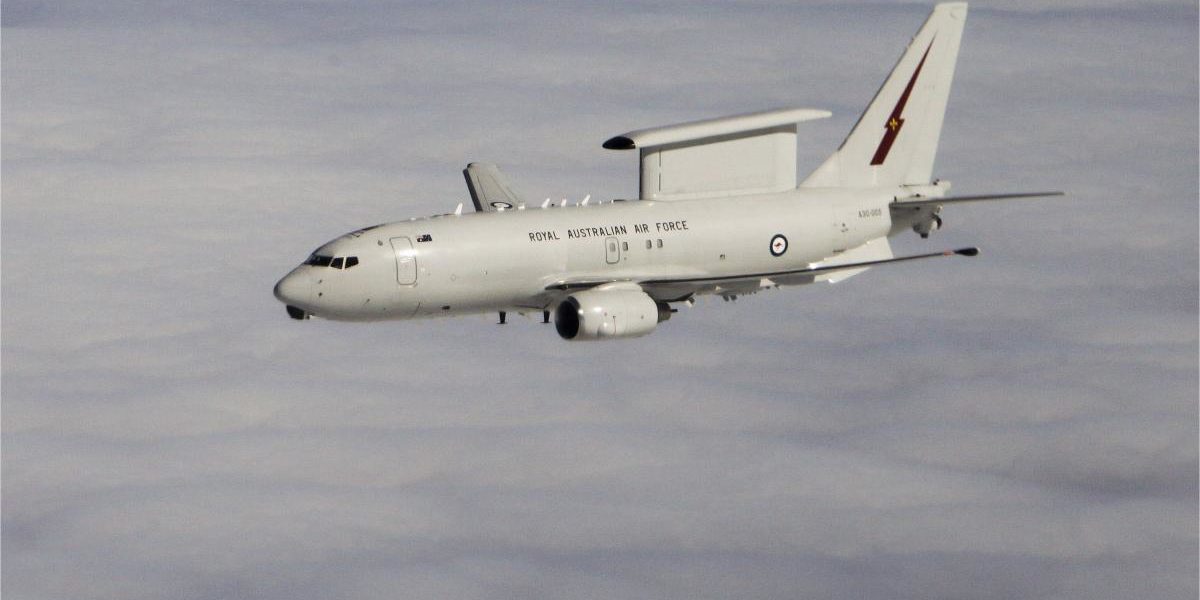Quick Facts
| Role | Airborne early warning and control (AEW&C) and command and control battle management (C2BM) |
| Targets | Aircraft, cruise missiles |
| Operators | Royal Australian Air Force, Republic of Korea Air Force, Turkish Air Force, Royal Air Force (UK) |
| Range | ~4,000 nautical miles |
| Sensors | Fixed Multi-Role Electronically Scanned Array (MESA) radar |
| Status | Operationally active with Royal Australian Air Force, Republic of Korea Air Force, Turkish Air Force. Royal Air Force (UK) has ordered three tails. |
| Producer | Boeing, with Northrop Grumman as subcontractor for active electronically scanned array radar |
Overview
The Boeing 737 Airborne Early Warning and Control (AEW&C) airframe, known as the E-7, is an air battlespace management platform, capable of detecting airborne threats including hostile aircraft and cruise missiles. Four countries operate the E-7: the Australian air force was the first to purchase the system, and has designated it the E-7A Wedgetail; the South Korean air force operates it under the name “Peace Eye”; the Turkish air force designates their four E-7s as the E-7T Peace Eagle, and the United Kingdom’s Royal Air Force operates it as the Wedgetail AEW1.
The E-7 consists of a Boeing 737-700 airframe, with the addition of a Northrop-Grumman produced Multi-Role Electronically Scanned Array (MESA) radar. This radar, which is fixed unlike the rotating radome of the E-3 Sentry (AWACS), has 360 degree capability with a 200+ nautical mile range in all weather conditions. The Australian air force deployed its Wedgetails to the Middle East for Operation Okra in support of the coalition fight against ISIS.
Current Developments
Air Force Chief of Staff, Gen. Charles Q. Brown, Jr., stated at the Air Force Association symposium that the service is “doing analysis” regarding procuring the Wedgetail. This comes after Pacific Air Forces commander Gen. Kenneth Wilsbach called for the Air Force to replace its aging E-3 Sentry fleet with the E-7.
Strategic Implications
The E-7 can direct and manage the battlespace, including incoming cruise missiles, at a bird’s-eye view, and serve as a strategic early-warning system. As a domain awareness platform, it eases access of our advanced fighters into anti-access, area-denial (A2/AD) areas.
Timeline
- July 1999: Australia selects Boeing’s 737 AEW&C system, over a Raytheon/Elta proposal and a Lockheed Martin bid.
- December 2000: Australia signs a contract with Boeing, for six AEW&C systems and four 737-700 airframes.
- June 2002: Turkey signs a contract for four AEW&C-capable aircraft.
- 2004: Australia exercises options to purchase two more 737-700 aircraft, bringing their total E-7 inventory to six aircraft.
- November 2006: Boeing and South Korea agree on a contract to provide four aircraft to the Republic of Korea Air Force.
- May 2010: Australia accepts the first E-7s into its air force.
- April 2014: The E-7 conducts its first operational sortie for Australia, in the search for Malaysia Airlines Flight 370.
- May 2015: The Australian Wedgetail fleet becomes Final Operationally Capable (FOC).
- 2020: The United Kingdom lowers its buy request from five Wedgetails to three.
- February 2021: Commander of the U.S.’s Pacific Air Forces, Gen. Kenneth S. Wilsbach, calls for the U.S. to procure the E-7 to replace its aging E-3 Sentry fleet.

